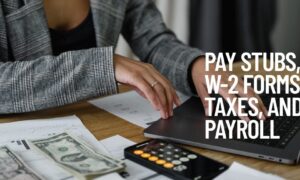Do you work for yourself as a self-employed independent contractor or freelancer? Depending on the amount of work you’ve done, you may get a 1099 form in the future. Nevertheless, what precisely is a 1099 and why is it so critical?
The 1099 Form: The Basics
Freelancers and independent contractors aren’t exempt from taxation because of their status as self-employed. In essence, 1099 papers inform the Internal Revenue Service of the amount a business paid you as a “non-employee” during the previous tax year. As a substitute for the W-2 forms that companies use to report income for workers, think of this data as you only qualify for 1099 if you provide services to a business rather than work directly for it. The majority of the time, an independent contractor is able to choose their own schedule and work as much or as little as they desire.
Do you currently work for a ride-sharing service? What are you doing for a friend’s company? In each of these cases, you would be qualified for a 1099 since you are an independent contractor. Choosing the 1099 services from Checkissuing is a good decision there.
If a business pays a freelancer less than $600 in a year, the independent contractor does not required getting a 1099. On the other hand, Freelancers must still report their earnings on their tax returns. This is when things start to become dangerous.
What You Need to Know About 1099s
Having a fundamental understanding of 1099 forms, we’ll now look at how an employer prepares a 1099 form. Here are a few things to keep in mind while preparing this paperwork for submission to the IRS:
Your Data Should Be Checked
Having accurate information on your contractors is critical. Each freelancer’s name, address, and Social Security number should be on a W-9 form that you’ve previously completed. Ask your independent contractors whether any of their personal information has changed.
Prepare your 1099 tax forms
At this point, getting your 1099s and getting started is all that’s left. One error to avoid here is utilizing a downloadable form or even a sample from the IRS. If this seems like a bother to you, that’s because it is. Use forms that can be read by the IRS scanners that handle 1099 forms instead.
Completing the Required Paperwork
This is the part that will take the most time to complete. The contractor’s details and your federal tax ID number should be included on each 1099 form. Box 7 under “Non-employee compensation” is where you’ll see the amount of money that was handed out to the contractor. Filling out the contact information forms is the last step. Because of this, completing 1099s by hand might take a considerable amount of time. That’s why an e-filing service like OnlineFileTaxes.com is recommended.
Send Out The Paperwork
You’ve spent a lot of time filling out 1099s and are now ready to send them out and go back to operating your company. Independent contractors must get their copy by the 1st of February through mail or personal delivery. You may be subject to significant IRS penalties if you miss this deadline.
Conclusion
Make duplicates for your own reference. Copy C is for your records and should not be thrown away. Keeping these data on hand is critical, even if you don’t want them cluttering up your workplace. The last thing you want is to be called by the IRS and not have your own copy of a contractor’s 1099.



































